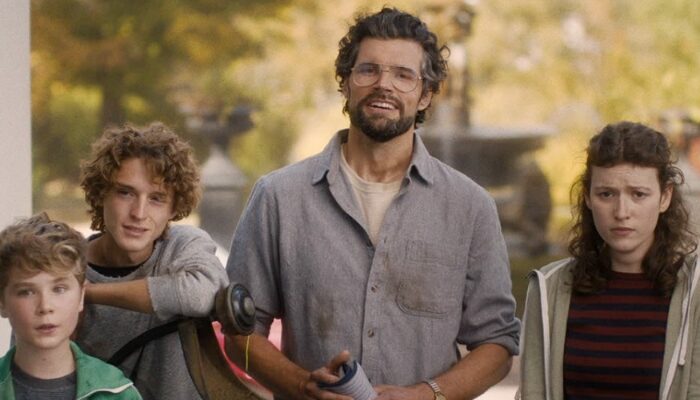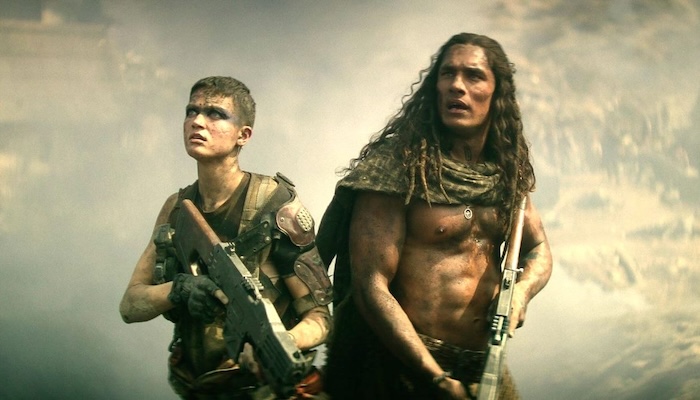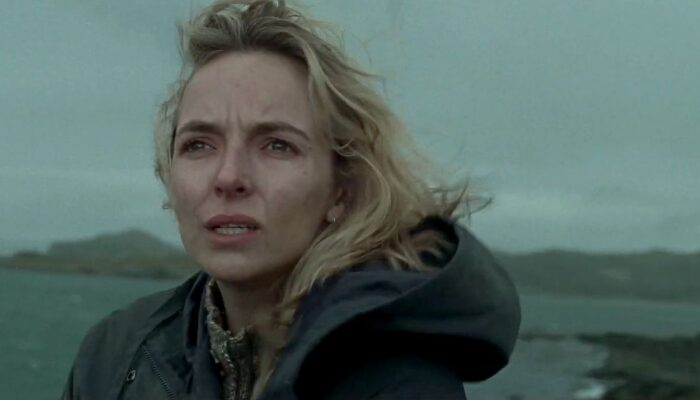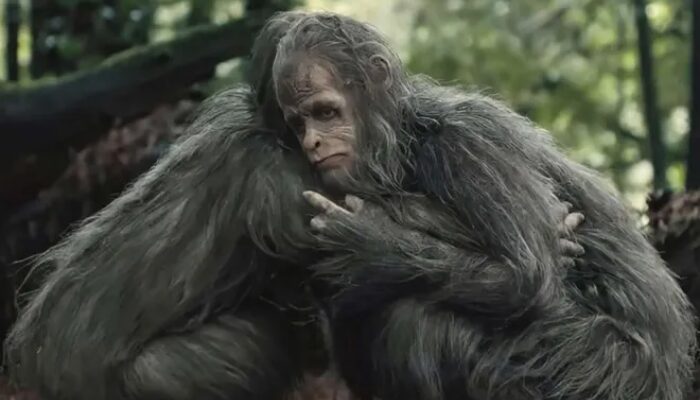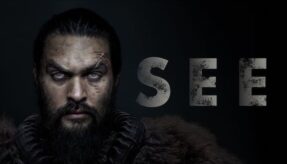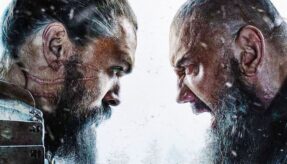TV Review: SEE: Season 1, Episodes 1-3: A Novel Plot-point Built Into An Enjoyable Tale That Surprises & Rewards [Apple TV+]
Table of Contents
See Season 1 Episodes 1-3 Review
See: Season 1, Episode 1: Godflame, Episode 2: Message in a Bottle, and Episode 3: Fresh Blood are the beginnings of one the most innovative TV series, when it comes to narratives, of the 2019 TV season. See is audacious in its presentation of the blind.
Watching a society built around having no sight, having never seen the world in which they inhabit, is immensely fascinating. This plot element alone draws the curious viewer in, because the viewer wants see to how humanity has learned to cope with blindness in a rural, de-industrialized world.
Those answers are delivered with Godflame, the first episode of See. The method of delivery is brilliant – preparations for a battle, the resulting skirmish, and the aftermath of the conflict. Seeing one blind army fight another blind army on a slopped hill in a forest presents the first most central question – how? – and then precedes to answer that question. Scent, sound, and generations of sightless training allow the blind to fight each other, to kill each other, enslave each other, and seek dominion over each other.
Blind Village Layout
The layout of the first two Alkenny villages are intelligently done – a mathematical grid where everything is equal lengths apart, square, with guide lines between huts/cabins and the central gathering area. This was an unexpected element but an adroit one by its builders. As soon as the viewer sees it, it makes sense, both in practicality and utility.
Imagination Stretch
There are areas of See that stretch the imagination e.g. Jerlamarel (Joshua Henry) being able to gather the materials for and constructing a bridge near a teeming village in secret.
DNA Clusters, Gene Pools, & The Dance
Dances are commonplace in middle school, high school, and college, a communal ritual that offers the chance to meet someone interesting and new. In See, dances share that same purpose but they are much more. ‘Dances’ in See are a right of passage, a chance not only to meet someone interesting and new, but a potential wife or husband. It would also seem that it is an opportunity for women to become inseminated with DNA from outside of their normal DNA cluster i.e. their village.
While watching the Dance, the viewer feels sorry for Nesta Cooper‘s Haniwa, whose acting sells her character’s shock and disbelief at what she is witnessing. Haniwa observes something (ahead of her time) that is not supposed to be seen but felt, a brand new experience for the sightless senses. Haniwa has been robbed of that eventual experience in two ways: 1.) her eye sight would and will prevent her from fully giving herself over to what is happening during the Dance. If she ever takes part in a Dance, her Dance partner selection wouldn’t be based on scent, sound, touch, and/or hormones. It will be based on what her potential partner looks like.
The sightless have lost many things but they have also gained many things as well. Chief among them being that the inner qualities of a person are of paramount value versus their physical appearance. Physical beauty (Maghra’s story beautifully illustrates this) and skin-color racism are extinct in the world of See.
And 2.) No surprise. When Haniwa is old enough to take part in a Dance, she will decline, missing out on that seminal experience. She will know exactly what is going to happen and what it’s about because she’s seen it. There will be no surprise. No promise of something new and exciting that she will love. In essence, there will be no draw for her.
Prejudice and The Future
There is also the other reason Haniwa will never take part in a Dance. Haniwa doesn’t want to marry a blind man, the type of man that currently makes up over 99% of the male population on the planet. From her words in Fresh Blood, Haniwa looks down on blind people, thinks that they are damaged or beneath her in some way.
Her mother and her father both hear this putdown (or implied putdown) in her comment “I’m not going to marry a blind man.” Her father’s rejoinder (paraphrase) “Your sight does not make you any better than anyone else” really drove its point home. It also drove home that Haniwa is not going to be a paint-by-numbers character. She will be flawed in what she says and how she thinks, making her more human, and more enjoyable to watch.
I foresee a dark possibility for Haniwa – she see herself as more and more superior as she grows older, as Queen Kane (Sylvia Hoeks) fears, and eventual wants to rule the blind world. The seeds of that potential plot-line were planted in Fresh Blood and its too devastating a narrative for writers Steven Knight and Hadi Nicholas Deeb not to have thought of. It’s also a plot-line to delicious to be ignored – the war between the few with sight versus the multitude without sight.
It will validate Queen Kane and her crusade against the light. The blind will flock to her harsh rule and protection. Those with sight wouldn’t be seen as witches by that point. They will be seen as devils.
The Queen
Sylvia Hoeks’ Queen Kane could have been just an ordinary monarchy desperate to hold onto her power via violence. That is what Kane essentially is, one-dimensional, but she is made into something more by her ‘religion,’ how she ‘prays,’ and how she ‘talks’ to God.
The viewer has never seen sexual contact and sexual exploitation twisted “just so” like it is in Godflame and Message in a Bottle.
Seeing Queen Kane commune with God through masturbation and pray to The Almighty by receiving oral sex is surprising and titillating. When I say surprising I mean the obvious but I also mean that the viewer is impressed that these moments give the viewer insight into the character they are beholding. These aren’t empty sex scenes built for flash and “wow,” though they produce those effects. They are submarines, dive-boards into the inner workings of The Queen’s mind. They also create is a new found admiration for Hoeks’ acting ability and how far she is willing to go for her characters.
There are not many characters that could…endure what Queen Kane endures while professing to potentially wipe the slate clean if her sworn enemy comes back and impregnates her with children that can see.
The Queen is conterminously afraid of those would-be children and their father. She fears humanity regaining the ability to see and the delicate balance that rules the Earth being shattered. It motivates her most profound actions in Godflame, Message in a Bottle, and Fresh Blood. It makes the Queen cruel and in some cases, irrational. If the world is on the precipice of change, she will need as many-allies that she can get, not less.
Hera Hilmar‘s acting
Hera Hilmar as Maghra does a good acting job (especially with her facial expressions) in the first two episodes but in Fresh Blood, when her character is nearly twenty years older, she is given moments where the emotional depths of her character come through. Example: Her pain at learning that she has been betrayed and lied two for years by those she loves is a fresh wound, one that causes her to scream in rage.
Cinematography
The cinematography in certain aspects of See is fantastic, coming close to some of Game of Thrones most beautiful moments e.g. when Brandon Stark & company reach the great Weirwood tree beyond The Wall in The Children.
Wondrous Slaver Fight
The best fight scene in the first three episodes of See is the one found in Fresh Blood. The staging, setup, and cinematography are perfection.
The square room (more math), its green color, the wet floor, and how that wetness (and sound) are manipulated make it more than a mere fight scene. It is a marquee event, one which Baba Voss (Jason Momoa) denotes the importance of, and the dread of his past, by throwing up before entering the ‘arena.’
Like its preamble, the fight contains a messy surprise as well – Voss isn’t just a master swordsman, he is a virtuoso with a sword (yet there is no explanation how he acquired those skills or who trained him. It’s left to the viewer’s imagination).
Because of those skills, the fight has a blind samurai-dynamic to it yet Baba Voss’ opponents are also blind, seemingly evening the odds…until the fight begins.
Choreographer Jo Willems and writers Knight and Deeb should be applauded for having their protagonist circle and ‘wrap’ his sword blade around his opponents’ necks, making the one kill opportunity the only opportunity needed.
Leave your thoughts on this See Season 1 Episodes 1-3 review and these episodes of See below in the comments section. Readers seeking more TV show reviews can visit our TV Show Review Page, our TV Show Review Twitter Page, our TV Show Review Facebook Page, and our TV Show Review Pinterest Page. Want up-to-the-minute notification? FilmBook staff members publish articles by Email, Twitter, Facebook, Instagram, Tumblr, and Flipboard.
Related Articles
FilmBook's Newsletter
Subscribe to FilmBook’s Daily Newsletter for the latest news!

